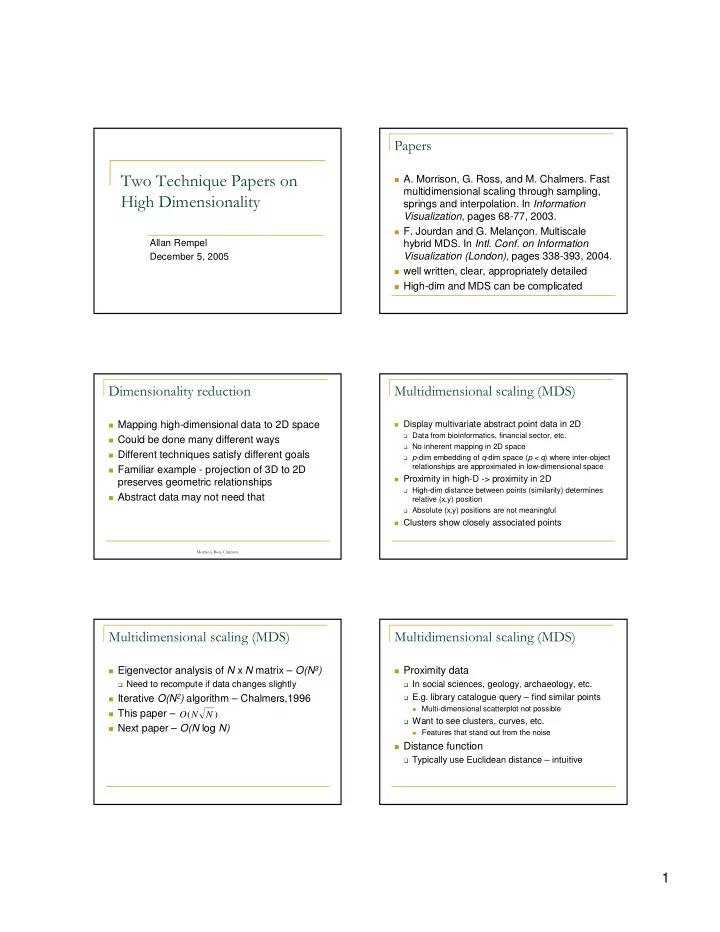

������ ������������������������ � A. Morrison, G. Ross, and M. Chalmers. Fast multidimensional scaling through sampling, ������������������� springs and interpolation. In Information Visualization , pages 68-77, 2003. � F. Jourdan and G. Melançon. Multiscale Allan Rempel hybrid MDS. In Intl. Conf. on Information December 5, 2005 Visualization (London) , pages 338-393, 2004. � well written, clear, appropriately detailed � High-dim and MDS can be complicated ������������������������ ������������������������������ � Mapping high-dimensional data to 2D space � Display multivariate abstract point data in 2D � Data from bioinformatics, financial sector, etc. � Could be done many different ways � No inherent mapping in 2D space � Different techniques satisfy different goals � p -dim embedding of q -dim space ( p < q ) where inter-object relationships are approximated in low-dimensional space � Familiar example - projection of 3D to 2D � Proximity in high-D -> proximity in 2D preserves geometric relationships � High-dim distance between points (similarity) determines � Abstract data may not need that relative (x,y) position � Absolute (x,y) positions are not meaningful � Clusters show closely associated points ������������������������ ������������������������������ ������������������������������ � Eigenvector analysis of N x N matrix – O(N 3 ) � Proximity data � Need to recompute if data changes slightly � In social sciences, geology, archaeology, etc. � Iterative O(N 2 ) algorithm – Chalmers,1996 � E.g. library catalogue query – find similar points � Multi-dimensional scatterplot not possible � This paper – O ( N N ) � Want to see clusters, curves, etc. � Next paper – O(N log N) � Features that stand out from the noise � Distance function � Typically use Euclidean distance – intuitive 1
������������� �������� �!""#���������� � Used instead of statistical techniques (PCA) � Approximate solution works well � Better convergence to optimal solution � Caching, stochastic sampling – O(N 2 ) � Iterative – steerable – Munzner et al, 2004 � Perform each iteration in O(N) instead of O(N 2 ) � Good aesthetic results – symmetry, edge � Keep constant-size set of neighbours lengths � Constants as low as 5 worked well � Basic algorithm – O(N 3 ) � Still only worked on datasets up to few 1000s � Start: place points randomly in 2D space � Springs reflect diff btwn high-D and 2D distance � #iterations required is generally O(N) ��$�������������%���������������������� &�����$���������������� � Diff clustering algorithms have diff strengths � Start: run spring model on subset of size N � Kohonen’s self-organising feature maps (SOM) � Completes in O(N) ( O ( N N )) ⋅ � K-means iterative centroid-based divisive alg. � For each remaining point: � Hybrid methods have produced benefits � Place close to closest ‘anchor’ � Neural networks, machine learning literature � Adjust by adding spring forces to other anchors � Overall complexity O ( N N ) '(������������������ '(������������������ � 3-D data sets: 5000 – 50,000 points � 13-D data sets: 2000 – 24,000 points � Took less than 1/3 the time of the O(N 2 ) � Achieved lower stress when done � Also compared against original O(N 3 ) model � 9 seconds vs. 577; and 24 vs. 3642 � Achieved much lower stress (0.06 vs. 0.2) 2
)���������* +������ ���������,�� � Hashing � Multiscale hybrid MDS � Pivots – Morrison, Chalmers, 2003 � Extension of previous paper 4 N O ( N ) � Achieved � Achieves O(N log N) time complexity � Dynamically resizing anchor set � Good introduction of Chalmers et al papers � Proximity grid � Like Chalmers, begins by embedding subset � Do MDS, then transform continuous layout into S of size N discrete topology -����.����������/%��������������� ���������� � Select constant-size subset P ⊂ S � For each p in P create sorted list L p � For each remaining point u , binary search L p for point u p as distant from p as u is � Implies that u and u p are very close � Chalmers et al is better for N < 5500 � Place u according to location of u p � Main diff is in parent-finding, represented by Fig. 3 ���������� 0��������%������� � Experimental study confirms theoretical results � MDS theory uses stress to objectively determine quality of placement of points � This technique becomes better for N > 70,000 � Subjective determinations can be made too � 2D small world network example (500 – 80,000 nodes) 3
���������� ��� ����������������%���������* � Series of results yielding progressively better time complexities for MDS � 2D mappings provide good representations � Further examination of multiscale approach � User-steerable MDS could be fruitful � Recursively defining the initial kernel set of points can yield much better real-time performance 4
Recommend
More recommend